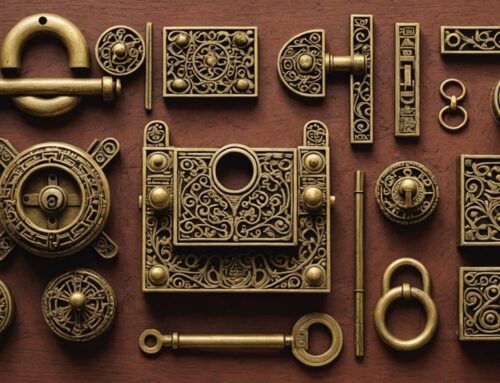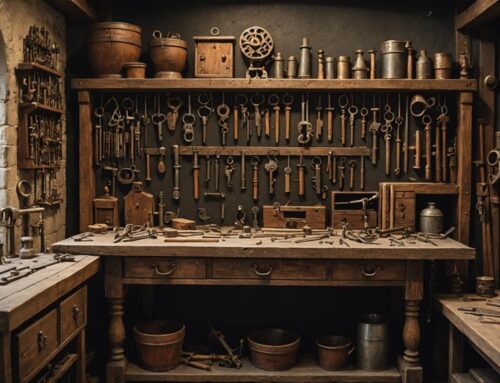You’re the hero in your own spy thriller, facing a locked door. No worries. You’ve got a paperclip. Welcome to ‘Unleash Your Inner Spy: Master Lock Picking With a Paperclip.’ We’re about to dive into lock mechanics, create makeshift lock-picking tools, and master the art of unlocking standard pin tumblers. By the end, you’ll have a unique skill, making you feel like a true spy. Remember, this is for fun and education, not mischief. Let’s start this adventure together.
Key Takeaways
- Mastering lock picking with a paperclip requires practice and skill.
- Understanding the mechanics of locks is important for successful lock picking.
- The necessary materials for lock picking include two big paperclips, pliers, and a tension wrench.
- To pick a lock, shape one paperclip into a lock pick and the other into a tension wrench, insert the tension wrench into the keyhole, turn it in the direction the lock turns, and rake the pick while applying pressure on the tension wrench.
Understanding Lock Mechanisms and Their Functionality
In grasping how to pick locks with a paperclip, you’ll need to understand the functionality of lock mechanisms and how they’re constructed. Familiarize yourself with different types of locks, as the lock picking techniques vary. Pin tumbler locks are common; they comprise a series of pins that prevent the lock from opening unless they’re pushed up to the correct height. Bumping or raking could help here. When dealing with wafer locks, usually found on cabinets or lockers, a rocking method is effective. As a budding lock-picker, you’ll make mistakes. A common one is using excessive force. Remember, it’s a finesse game, not a strength test. Also, ignoring feedback from your tools won’t help your cause. Engage your senses and learn from the lock.
Crafting Your Paperclip Lock Picking Tools
You’ve got to shape up your paperclips properly for lock picking, but don’t forget to also make a tension wrench for optimal performance. It’s critical when creating custom lock picks. With just a couple of paperclips and some pliers, you can craft your unique lock picking tools. But remember, it’s not just about making the tools, it’s about knowing how to use them effectively. Here are some tips for improving lock picking skills:
| Step | Tool | Action |
|---|---|---|
| 1 | Paperclip 1 | Shape into lock pick |
| 2 | Paperclip 2 | Create tension wrench |
| 3 | Tension Wrench | Apply pressure in lock turning direction |
| 4 | Lock Pick | Insert into keyhole, rake and jiggle |
| 5 | Both Tools | Depress pins while maintaining pressure |
With practice, you’ll belong to the group of skilled lock pickers.
The Art of Lock Picking With Paperclips
Mastering the art of lock picking with paperclips isn’t just about bending metal, it’s understanding the intricacies of the lock’s mechanism. You’re part of an elite group interested in alternative lock picking tools and the skills they require.
- Tool Preparation – Transform two paperclips into your lock picking tools. Don’t overlook the importance of your tension wrench; it’s as crucial as your pick.
- Lock Manipulation – Apply just the right amount of pressure, too much or too little, and you’ll fail. This is one of the common mistakes in lock picking.
- Pin Setting – Feel the pins, set them one at a time with patience. Rushing here lands you back at square one.
Step-by-Step Guide: Lock Picking Technique Part 1
We’re now moving on to the first part of our step-by-step guide, but don’t forget, you’ll need two large paperclips, pliers, and a tension wrench to get started. Now, why choose lock picking as a hobby, you may ask? Well, the benefits of learning lock picking stretch beyond just having a unique skill set. It stimulates your mind, enhances focus, and boosts problem-solving skills. Plus, it’s a fascinating party trick! To improve your lock picking skills quickly, you must practice. A lock and your makeshift tools are your new best friends. Study the lock, understand its mechanism. And remember, patience is key. So, let’s embark on this journey of mastering lock picking together.
Step-by-Step Guide: Lock Picking Technique Part 2
In this part of the guide, you’ll delve deeper into the lock picking process, focusing on using your tension wrench and paperclip pick to outsmart the lock mechanism. You’ve prepared your makeshift tools and now it’s time to carefully navigate that lock.
- Start by inserting your tension wrench into the lower part of the keyhole. Apply gentle pressure in the direction the lock turns.
- Next, slide your paperclip pick into the top part of the keyhole. Use a raking motion while applying slight upwards pressure.
- Finally, maintain consistent pressure on the wrench while manipulating the lock’s pins with your pick.
Frequently Asked Questions
Is Lock Picking With a Paperclip Legal in All Jurisdictions?”
No, lock picking with a paperclip isn’t legal in all jurisdictions. Laws vary by location. Mastering this skill can carry legal consequences if misused. Always respect property rights and use paperclip alternatives for legal purposes.
What Types of Locks Can Be Picked With a Paperclip?”
You can pick basic pin tumbler locks with a paperclip. However, more durable locks may require specialized tools. Remember, paperclips aren’t your only option. Other household items can serve as effective alternatives.
How Can I Improve My Lock Picking Skills With a Paperclip?”
To improve your lock picking skills with a paperclip, focus on mastering tension control. Practice regularly, experiment with paperclip alternatives for different locks, and understand the mechanics of each lock you attempt to pick.
What Are Some Common Mistakes People Make When Trying to Pick a Lock With a Paperclip?”
You’re not alone in making mistakes when picking locks with a paperclip. Common blunders include using too much force, picking in the wrong direction, or overlooking paperclip alternatives. Remember, respect lock picking ethics.
Are There Any Safety Concerns or Potential Damages to the Lock When Using a Paperclip to Pick It?”
Yes, there are potential risks. Your paperclip’s durability may not match a traditional pick’s, risking breakage inside the lock. This could damage the lock’s integrity and make it unusable or difficult to repair.








